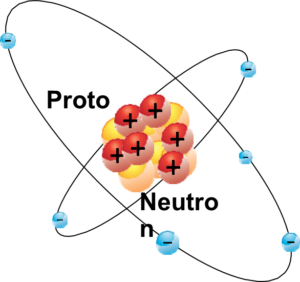Nuclear power plants produce almost zero greenhouse gas emissions. Could they be the answer to the climate change problem? Scientists have gone a long way before they made it possible to use nuclear power to produce electricity for industry and households. First, it was found that all substances consist of many similar particles, called molecules. Then it was discovered that the molecules themselves are constructed from a set of atoms. Different types of atoms were called ‘chemical elements.’ They were numbered and listed in Mendeleev’s Periodic Table.
 Under certain conditions the molecules of various substances can break down into their atoms and form the molecules of new substances in a process called a ‘chemical reaction’. During a chemical reaction the energy holding the atoms together is released. The new compounds may require more energy or less, so that the chemical reaction may absorb energy from the space around it or may give off energy into space. The combustion of fossil fuel is a chemical reaction that produces heat.
Under certain conditions the molecules of various substances can break down into their atoms and form the molecules of new substances in a process called a ‘chemical reaction’. During a chemical reaction the energy holding the atoms together is released. The new compounds may require more energy or less, so that the chemical reaction may absorb energy from the space around it or may give off energy into space. The combustion of fossil fuel is a chemical reaction that produces heat.
But what would happen if changes occurred within the structure of the atom itself, rather than the molecule? Scientists have found that the atom also consists of particles: it has a nucleus, made of protons and neutrons welded tightly together, around which electrons revolve. The nuclei of some chemical elements can break up. This produces, first, a large amount of heat energy (which can be collected and used), and second, special particles that are called radiation. This phenomenon is called ‘radioactive decay’ or ‘radioactivity’.
Radioactivity is part of the nature of our planet. On average, according to data from the International Atomic Energy Agency, the global annual amount of natural background radiation per individual is about 2.4 millisieverts (mSv) per year. Such low doses of radiation are harmless and even necessary for human beings and the whole natural environment. However, at higher doses radiation can be deadly.
 In 1975, experts in the United States made the first attempt to calculate the probability of serious accidents at nuclear power plants. They found that such an accident could happen once every 10,000 years. And yet it was only four years before just such an accident occurred at the Three Mile Island nuclear power plant near the town of Harrisburg. The immediate damage from the accident was estimated at one billion dollars and the indirect damage at $100 billion, although only a few people were affected by radiation leakage. Seven years later, an accident occurred at a nuclear power station near the town of Chernobyl in the former Soviet Union, where nuclear scientists had also insisted that it could only happen once every 10,000 years.
In 1975, experts in the United States made the first attempt to calculate the probability of serious accidents at nuclear power plants. They found that such an accident could happen once every 10,000 years. And yet it was only four years before just such an accident occurred at the Three Mile Island nuclear power plant near the town of Harrisburg. The immediate damage from the accident was estimated at one billion dollars and the indirect damage at $100 billion, although only a few people were affected by radiation leakage. Seven years later, an accident occurred at a nuclear power station near the town of Chernobyl in the former Soviet Union, where nuclear scientists had also insisted that it could only happen once every 10,000 years.
Klaus Taube, the former head of the German company, Interatom, has said that any statistical estimates of the probability of an accident with meltdown of nuclear fuel elements must be considered as pseudo-scientific nonsense.
People have learnt to control nuclear reactions and use the energy they release. This process is the basic mechanism used by nuclear power plants. A nuclear power plant uses the complex process of radioactive nuclear decay as a source of energy. An enormous amount of energy can be derived from a small amount of nuclear fuel without the emission of any GHGs into the atmosphere. In terms of its impact on climate, nuclear power is very safe, although it should be remembered that the extraction of uranium for use in nuclear power plants consumes a lot of energy and emits a lot of greenhouse gases.

 The major downside of nuclear power plants is that the new nuclei – called daughter nuclei – formed by the artificially organized, energy- producing decay, may also be radioactive. They are not useful as fuel but cannot be returned to the natural environment since they are dangerous. Scientists have been thinking carefully about different means of safely disposing this ‘radioactive waste.’ Pilot projects are under way for a new generation of nuclear power technology in which radioactive waste from existing nuclear power stations is used as input fuel with modern technologies based on fast neutron reactors with advanced fuel cycles.
The major downside of nuclear power plants is that the new nuclei – called daughter nuclei – formed by the artificially organized, energy- producing decay, may also be radioactive. They are not useful as fuel but cannot be returned to the natural environment since they are dangerous. Scientists have been thinking carefully about different means of safely disposing this ‘radioactive waste.’ Pilot projects are under way for a new generation of nuclear power technology in which radioactive waste from existing nuclear power stations is used as input fuel with modern technologies based on fast neutron reactors with advanced fuel cycles.
There is also ongoing and promising research on small modular nuclear reactors that could provide energy directly to cities. If these methods worked as perfectly as planned, it could indeed be said that nuclear power plants are completely harmless. However, the health and safety issues of nuclear plants remain a major concern. The dangers associated with the use of nuclear energy, which remain even after a nuclear plant is closed, have led to an ongoing debate about whether to develop nuclear power plants further or to prohibit them.
The explosion at the Chernobyl nuclear power plant on 26 April 1986 shocked the world. Many people were killed or seriously injured. About five million hectares of land (comparable in size with a country like Slovakia) became unusable for agriculture. A 30-km exclusion zone was created around the accident site and hundreds of small settlements had to be abandoned and destroyed.
Many years have now passed, and the designers of nuclear power plants now claim that the mistakes of the past will not be repeated with new and better equipment that has been invented.
However, in current conditions, when the climate is undergoing major changes, it is not possible to predict exceptional natural phenomena. During the construction of nuclear power plants in Japan, the frequent occurrence of earthquakes in that country was, of course, considered. Nevertheless, on 11 March 2011, a powerful earthquake and the resulting tsunami led to the failure of all systems for normal and emergency cooling of the reactor core at a Japanese nuclear power plant, and thermal explosions ensued. A large amount of radioactive material was released into the sea and the air, and the effect was felt in many countries. Three years later, the levels of radiation on the coastline where the Fukushima-1 nuclear power plant is located still exceeded normal levels by more than 100 times. As many as 80,000 people had to be moved from the area. Despite assurances from the Japanese authorities that the situation had stabilized, more radioactive substances entered the groundwater beneath the station two years after the accident and their concentrations grew, and there was further leakage from radioactive water tanks.
Nuclear energy is powerful energy, but it is also dangerous. The devastation it can cause if it runs out of control means that it is neither safe, nor cheap. Nevertheless, there is increased attention recently to nuclear energy because of the fast-growing demand for electricity and pressure to reduce carbon dioxide emissions from electricity production.


